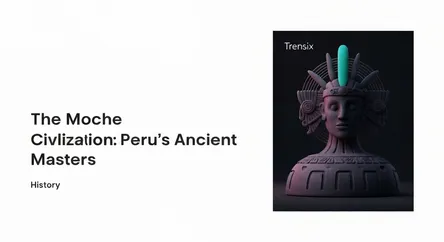History
The Moche Civilization: Peru's Ancient Masters

Discover the Moche Civilization, a sophisticated pre-Incan culture known for its impressive adobe pyramids, intricate pottery, and goldwork.
What is it?
The Moche civilization flourished on the northern coast of Peru from approximately 100 to 800 AD. Not a unified empire, they were likely a group of self-governing states that shared a common culture. The Moche were skilled agricultural engineers, building a sophisticated network of irrigation canals to farm the arid land. They are renowned for their monumental adobe structures, called "huacas," such as the Huaca del Sol and Huaca de la Luna, which served as ceremonial and political centers. Moche artists were incredibly skilled, producing some of the finest naturalistic and vibrant pottery, metalwork, and murals in the ancient Americas, which depicted their daily life, religion, and warfare in great detail.
Why is it trending?
The Moche civilization remains a topic of fascination due to its complex culture and mysterious collapse. Ongoing archaeological discoveries at sites like Sipán and Huaca de la Luna continue to unveil stunning artifacts, including elaborate tombs filled with gold, and well-preserved murals. These findings provide new insights into their rituals, which included human sacrifice. Furthermore, their highly realistic and sometimes graphic ceramic art, especially the portrait and erotic vessels, generates widespread interest for what it reveals about their beliefs and social structure. The reasons for their decline, believed to be a combination of extreme El Niño events, drought, and internal conflict, are still debated by scholars.
How does it affect people?
The Moche civilization provides a crucial window into the rich history of the Andean region before the Inca Empire. Their legacy is a significant part of Peru's cultural heritage, with their archaeological sites being major centers for tourism and research. Their advanced techniques in ceramics, metallurgy, and hydraulic engineering demonstrate a high level of innovation and continue to be studied today. As the Moche had no known written language, their detailed art is the primary source for understanding their world, offering a direct connection for modern people to the lives and beliefs of this ancient culture.